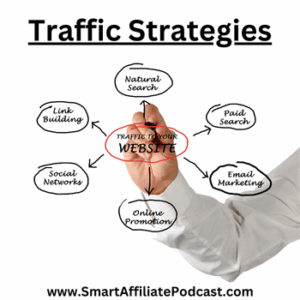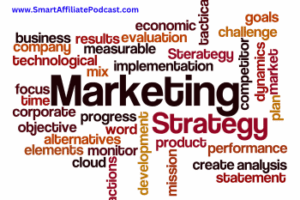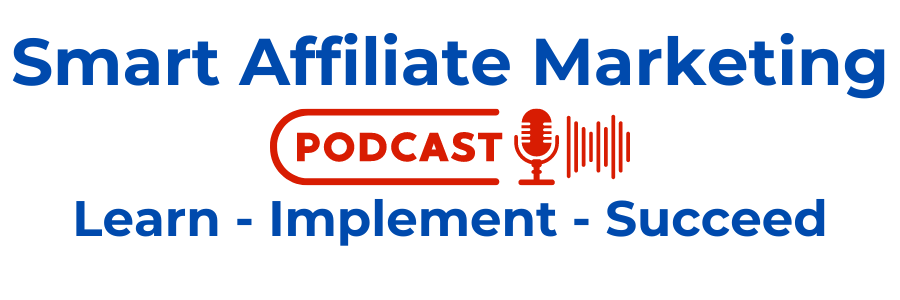Chapters
0:00 – Introduction
0:41 – The “Free vs Paid Traffic” Question
0:59 – Key Considerations
1:16 – Understanding Your Audience
1:34 – Free Traffic Methods
1:57 – Advantages of Free Traffic
2:36 – Disadvantages of Free Traffic
3:07 – Paid Traffic Methods
3:44 – Advantages of Paid Traffic
4:04 – Disadvantages of Paid Traffic
4:34 – How to compete with established marketers
6:07 – Comparing Free and Paid Traffic Sources & Considerations
7:26 – Creating your own hybrid approach
7:48 – Best practices for traffic generation
9:16 – Some lead generation statistics from survey.net
11:06 – Summary of the free versus paid traffic arguments
12:02 – Outro and Music
Episode Overview
 This episode of the Smart Affiliate Marketing Podcast tackles a common challenge for affiliate marketers: free vs paid traffic. The host dives into the pros and cons of each approach, including cost, time investment, audience targeting, and long-term sustainability. He also explores best practices for traffic generation, like keyword research, content creation, and email list building. Listeners will learn how to choose the right strategy for their business and get started generating traffic.
This episode of the Smart Affiliate Marketing Podcast tackles a common challenge for affiliate marketers: free vs paid traffic. The host dives into the pros and cons of each approach, including cost, time investment, audience targeting, and long-term sustainability. He also explores best practices for traffic generation, like keyword research, content creation, and email list building. Listeners will learn how to choose the right strategy for their business and get started generating traffic.
Benefits of Listening
- Understand the advantages and disadvantages of free vs paid traffic for affiliate marketing.
- Learn best practices for traffic generation, including keyword research, content creation, and email marketing.
- Discover how to choose the right traffic generation strategy for your affiliate marketing business.
- Gain insights from traffic generation statistics.
Key Takeaways
- There’s no one-size-fits-all answer to free vs paid traffic. Consider factors like budget, timeframe, and target audience.
- Free traffic methods are cost-effective but take time to build an audience.
- Paid traffic delivers faster results but can be expensive and requires ongoing investment.
- Building a strong email list is crucial for nurturing leads, regardless of traffic source.
- Content marketing is a powerful tool for generating free traffic and building relationships with potential customers.
Best Moments
- “The burning question of should I use free traffic or paid traffic?”
- “Free traffic…can lead to a more engaged audience because you’re providing ongoing content for them.”
- “Paid traffic…you’ll get faster results and your audience is highly targeted.”
- “Content marketing strategy delivers three times more leads than outbound lead generation strategies.”
- “Build the know, like and trust, give them good content, build that relationship and then they will buy from you further down the line.”
Summary of Free Traffic vs Paid Traffic
 This episode explores the debate between free and paid traffic generation for affiliate marketers. The host acknowledges that traffic generation is a major challenge for many marketers and offers a breakdown of both approaches. Free traffic methods like SEO, content marketing, and social media engagement are cost-effective but require consistent effort and time investment to see results. Paid traffic options like PPC ads and influencer marketing deliver faster results and targeted reach, but come with a price tag and ongoing expenses.
This episode explores the debate between free and paid traffic generation for affiliate marketers. The host acknowledges that traffic generation is a major challenge for many marketers and offers a breakdown of both approaches. Free traffic methods like SEO, content marketing, and social media engagement are cost-effective but require consistent effort and time investment to see results. Paid traffic options like PPC ads and influencer marketing deliver faster results and targeted reach, but come with a price tag and ongoing expenses.
The episode emphasizes the importance of understanding your target audience and their online behavior to choose the most effective traffic generation strategy. It highlights the long-term value of building digital assets with free traffic methods and the scalability of paid traffic for quick wins. Ultimately, the best approach may involve a hybrid strategy that leverages both free and paid methods.
The host concludes by offering best practices for traffic generation, including keyword research, content creation, and email list building. He suggests valuable resources like ebooks and online tutorials to help listeners become experts in their niche and generate targeted traffic for their affiliate marketing businesses.
Complete Transcript
SAM-Episode-16-Traffic (Free vs Paid)
Hello and welcome to the Smart Affiliate Marketing Podcast.
Did you know that according to survey.net, over 60% of marketers believe that traffic generation is their biggest challenge?
Have you ever wondered if it’s better to invest time and effort into free traffic or simply pay for your traffic?
In this episode, I’m going to answer this burning question.
I’m going to dive deep into the world of traffic generation and explore the pros and cons of both free traffic and paid traffic sources.
Firstly, let’s look at the burning question of should I use free traffic or paid traffic. I’ll discuss the advantages and disadvantages of each of the methods and compare and contrast these approaches to help you determine the best strategy for your affiliate marketing business.
One of the first steps and key considerations in determining your traffic strategies is to find out where your audience and potential customers hang out.
By doing this, you’ll be casting your line into the right places. Now, you’ve probably worked this out already. But if you haven’t, that would be your first step. For example, do they hang out in social media groups or are they typing keyword searches into Google? Understanding where they hang out can be a big factor in determining your traffic strategies.
Let’s now look at some of the methods of traffic generation.
First up, we’re going to look at free traffic. Some examples of free traffic are search engine optimization, then content marketing by blogging, guest posting and creating web pages, there’s email marketing, social media, marketing and community engagement such as forums and other groups within your niche.
So let’s look at the pros or advantages of free traffic.
Firstly, it is of course cost effective in the fact that it’s free.
You can build organic reach over time as your website and blog increases in size, so will your traffic.
It can lead to a more engaged audience because you’re providing ongoing content for them that they can digest and it builds the “know, Like and Trust.
And in summary, you’re creating digital assets that will last a long time. For example, a well optimized blog post will be on the internet for as long as you continue to pay your hosting or decide to take it down.
However, there are a few downsides to free traffic. The cons are that it is time consuming, it requires consistent effort and it may take a long time to see results.
In the book “Affiliate marketing for dummies” it states that new affiliate marketers may take between three and eight months to see any returns whatsoever on their time invested. That is a guideline, it can take shorter or longer.
But one way around this would be to pay for your traffic.
So let’s look at paid traffic and a few examples of what paid traffic actually is.
So there’s pay per click advertising on Google or Facebook ads, for example, whereby you bid on a keyword or number of keywords in order for your advert to be displayed for that keyword.
There’s display advertising whereby you have banners and images on other people’s websites, then there’s native advertising, an example of which is a sponsored article or a sponsored video. And then there’s influencer marketing as well whereby somebody with a large audience base may promote the product for you.
The advantages and pros of using paid traffic are firstly, you’ll get faster results and your audience is highly targeted.
You also get a measurable return on investment. If you know your numbers, you’ll be able to determine which of your ads are successful and which need to be improved.
The downsides or cons to pay traffic are that it can be expensive. Many niches are now mature markets, so it’s going to be hard to compete with established marketers who have already optimized their sales funnels for the maximum return on investment, thereby enabling them to spend more per click than you can afford – while still making a profit.
Paid traffic does require ongoing investment, so you have to keep paying for traffic on an ongoing basis and it can be less sustainable if it’s not managed properly.
Let’s go back to the second point I made there about niches being mature markets so it’s hard to compete with established marketers.
So let’s look at an example of an established business. They’ve optimized their sales funnel and for each click they pay for, they make $5.50 total in return. If the clicks cost them $5 each, they will still be making a positive return on investment. However, if you’re a new un-optimized business, your sales funnel may only produce revenue of say $1 per click. So it’s going to be hard for you to outbid these established businesses unless you’re prepared to take a hit during the optimization process.
So the way to overcome this challenge and compete in established markets is to have an expendable budget so that you can split test and optimize your sales funnel as quickly as possible.
Yes, you will probably or undoubtedly lose money in the early stages of this process. But by doing this, you will be optimizing your campaigns on an ongoing basis until you are eventually making a positive return on your ad spend. You simply keep A/B testing and tweaking the landing pages and sales pages, adding upsells, downsells, side-sells and so on – all the while establishing the optimum strategy and gradually increasing your incoming revenue until you can bid for clicks at the same rates as established businesses can, whilst returning a positive ROI.
So, that’s an overview of the main free traffic and paid traffic sources.
Now, let’s compare them and what you need to consider.
First of all is your budget. If you don’t have a massive ad spend budget, then you’re going to need to take the free route until you can afford perhaps to pay for some traffic.
Your time frame will have a big bearing on which methods you decide to use. If you need quick results, you’re gonna have to pay for them. But if you don’t have the budget, then you’re kind of snookered. But you could start small and scale.
It also depends on the first thing we mentioned today, which is where your target audience hangs out. If it’s a niche where people huddle together in social media groups rather than go to Google and type in keywords to search what they’re looking for, then obviously you’ll need to target these social media groups.
Whereas if your target audience are typing things into Google, you’ll either need an optimized web page or blog post for that keyword or you’ll need to bid on that keyword with pay per click.
You should also consider the long term sustainability.
Whilst you can get a pay per click campaign to be producing a positive return on investment, it does mean that you’ve continually got to pay for your clicks and leads and traffic.
Whereas with free traffic, you’re building up a digital asset base which is going to produce revenue over a long period of time with no extra input.
And you may, like many marketers do, create your own hybrid approach by combining free and paid traffic for optimal results.
For example, you could build a website and blog or create a youtube channel with great content for your target audience. But if you find you’re not getting much traffic, you could then pay per click to get traffic to your blog, to your videos and to your landing pages.
Let’s look now at some best practices for traffic generation.
Most traffic generation is based on keywords. Now, hopefully you’ve done your keyword research by now. If not, you need to identify relevant keywords and then optimize your content for the search engines according to the keywords your target audience are searching for.
Once you’ve established, what the keywords are, you then create quality content, which is valuable and engaging that resonates with your target audience and draws them in to what you have to say.
You should also have some lead magnets whereby you swap something valuable in return for an email address, so that you can market to these people on an ongoing basis. But of course, don’t just market to them, keep providing them with good content via your emails.
And of course, you can use social media to build engagement by having a strong online presence and interacting with your target audience, be it in a group that you create or perhaps somebody else’s.
And you should obtain analytics from your website and any other platforms that you can to understand which of your strategies are working, which are not, and then you do more of what’s actually working.
And if you’re going to go into pay per click, you could start with the low hanging fruit, which is perhaps longer tail keywords with a lower cost per click whilst you’re setting up and optimizing your funnels until it’s producing a better return on investment. And then perhaps you could add some more keywords into your marketing mix.
Now, I’m gonna give you a few lead generation statistics from survey.net.
According to their surveys, 53% of marketers spend at least half of their marketing budget on lead generation – makes sense, right?
95% of marketers believe they know which channels drive the most leads to their business.
61% of marketers consider generating traffic in leeds to be their biggest challenge.
And still from survey.net, they’re saying that content marketing strategy delivers three times more leads than outbound lead generation strategies.
That gives me a strong indication that content marketing is perhaps the way forward, especially for a beginner, unless you have a large budget.
Survey.net also says that 63% of leads inquiring about the business won’t convert for at least three months. This to me highlights the importance of getting people onto an email list because they won’t buy right away.
You need to build the know, like and trust, give them good content, build that relationship and then they will buy from you further down the line.
So whether you’re using free traffic or paid traffic, it’s very important to get people onto your email list by giving them an ethical bribe such as a free report or something of value to anyone within your niche.
Now, if you’re thinking I’d love to do the free traffic, but I’m rubbish at content creation. Well, there’s a simple solution. There’s plenty of books on ebay and Amazon to help you. Read the reviews of these books, look at the descriptions to see if it resonates with you and what you’re looking for.
Or you can watch videos on youtube or simply Google “content creation strategies” and you can soon learn how to create some great content that’s going to resonate with your audience.
So, in summary of the free versus paid traffic arguments, we’ve looked at the pros and cons of each, the arguments for and against each one. We’ve looked at situations whereby free traffic may be better than paid or vice versa.
We’ve looked at how to optimize pay per click campaigns, perhaps take the low hanging fruit bidding for those keywords first while you’re in the process of optimizing your funnel. This is simply so that you don’t lose bucket loads of money in the process of optimizing your campaigns.
In future episodes, I will be going more deeply into various traffic methods. This has basically been an overview to help you sort of decide which general traffic generation strategies are most suitable for your business. Whichever strategies you’re looking for, there are plenty of books on Amazon, there’s videos on youtube and plenty of articles you can find on Google to learn more and become an expert in your niche.
I hope you’ve found this episode helpful.
Feel free to like, follow, subscribe, write a review, share with your fellow marketers and look out for future episodes where I’ll take deeper dives into various traffic sources.
Until next time, Have a great day and I’ll see you soon!
